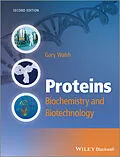Proteins Biochemistry and Biotechnology 2e is a definitive
source of information for all those interested in protein science,
and particularly the commercial production and isolation of
specific proteins, and their subsequent utilization for applied
purposes in industry and medicine.
Fully updated throughout with new or fundamentally revised
sections on proteomics as, bioinformatics, protein
glycosylation and engineering, well as sections
detailing advances in upstream processing and newer
protein applications such as enzyme-based biofuel
production this new edition has an increased focus on
biochemistry to ensure the balance between biochemisty and
biotechnology, enhanced with numerous case studies.
This second edition is an invaluable text for undergraduates of
biochemistry and biotechnology but will also be relevant to
students of microbiology, molecular biology, bioinformatics and any
branch of the biomedical sciences who require a broad overview of
the various medical, diagnostic and industrial uses of proteins.
* Provides a comprehensive overview of all aspects of protein
biochemisty and protein biotechnology
* Includes numerous case studies
* Increased focus on protein biochemistry to ensure balance
between biochemisty and biotechnology
* Includes new section focusing on proteomics as well as
sections detailing protein function and enzyme-based biofuel
production
"With the potential of a standard reference source on the topic,
any molecular biotechnologist will profit greatly from having this
excellent book. " (Engineering in Life Sciences, 2004; Vol
5; No. 5)
"Few texts would be considered competitors, and none compare
favorably." (Biochemistry and Molecular Education,
July/August 2002)
"...The book is well written, making it informative and easy to
read..." (The Biochemist, June 2002)
Autorentext
Gary Walsh, University of Limerick, Ireland.
Klappentext
Proteins Biochemistry and Biotechnology 2e is a definitive source of information for all those interested in protein science, and particularly the commercial production and isolation of specific proteins, and their subsequent utilization for applied purposes in industry and medicine.
Fully updated throughout with new or fundamentally revised sections on proteomics as, bioinformatics, protein glycosylation and engineering, well as sections detailing advances in upstream processing and newer protein applications such as enzyme-based biofuel production this new edition has an increased focus on biochemistry to ensure the balance between biochemisty and biotechnology, enhanced with numerous case studies.
This second edition is an invaluable text for undergraduates of biochemistry and biotechnology but will also be relevant to students of microbiology, molecular biology, bioinformatics and any branch of the biomedical sciences who require a broad overview of the various medical, diagnostic and industrial uses of proteins.
• Provides a comprehensive overview of all aspects of protein biochemisty and protein biotechnology
• Includes numerous case studies
• Increased focus on protein biochemistry to ensure balance between biochemisty and biotechnology
• Includes new section focusing on proteomics as well as sections detailing protein function and enzyme-based biofuel production
"With the potential of a standard reference source on the topic, any molecular biotechnologist will profit greatly from having this excellent book. " (Engineering in Life Sciences, 2004; Vol 5; No. 5)
Few texts would be considered competitors, and none compare favorably." (Biochemistry and Molecular Education, July/August 2002)
"...The book is well written, making it informative and easy to read..." (The Biochemist, June 2002)
Inhalt
Preface xi
About the Companion Website xiii
Chapter 1 Proteins and proteomics 1
1.1 Proteins, an introduction 1
1.2 Genes, genomics and proteomics 2
1.3 Bioinformatics 12
1.4 Proteomics: goals and applications 14
Further reading 22
Chapter 2 Protein structure and engineering 25
2.1 Primary structure 25
2.2 Higher-level structure 36
2.3 Protein classification on the basis of structure 41
2.4 Protein structural stability 45
2.5 Higher-order structure prediction 47
2.6 Protein folding 48
2.7 Intrinsically disordered proteins 50
2.8 Protein engineering 51
2.9 Protein post-translational modification 54
Further reading 62
Chapter 3 Protein sources 65
3.1 Recombinant versus non-recombinant production 65
3.2 Approaches to recombinant protein production 67
3.3 Heterologous protein production in E. coli 72
3.4 Heterologous production in bacteria other than E. coli 77
3.5 Heterologous protein production in yeast 77
3.6 Heterologous protein production in fungi 78
3.7 Proteins from plants 80
3.8 Animal tissue as a protein source 84
3.9 Heterologous protein production in transgenic animals 85
3.10 Heterologous protein production using animal cell culture 86
3.11 Insect cell culture systems 87
Further reading 88
Chapter 4 Protein purification and characterization 91
4.1 Protein detection and quantification 93
4.2 Initial recovery of protein 95
4.3 Removal of whole cells and cell debris 98
4.4 Concentration 103
4.5 Chromatographic purification 107
4.6 Protein inactivation and stabilization 128
4.7 Protein characterization 137
Further reading 139
Chapter 5 Large-scale protein production 141
5.1 Upstream processing 141
5.2 Downstream processing 154
5.3 Therapeutic protein production: some special issues 163
5.4 Range and medical significance of impurities potentially present in protein-based therapeutic products 166
Further reading 175
Chapter 6 Therapeutic proteins: blood products, vaccines and enzymes 177
6.1 Blood products 177
6.2 Anticoagulants 184
6.3 Thrombolytic agents 186
6.4 Additional blood-related products 189
6.5 Vaccine technology 190
6.6 Therapeutic enzymes 194
Further reading 202
Chapter 7 Therapeutic antibodies 205
7.1 Antibodies 205
7.2 IgG structure and activity 205
7.3 Antibody therapeutics: polyclonal antibody preparations 209
7.4 Antibody therapeutics: monoclonal antibodies 211
7.5 Therapeutic applications of monoclonal antibodies 220
7.6 Antibody conjugates 223
7.7 Bispecific antibodies 224
7.8 Antibody fragments 225
7.9 Engineering the antibody glycocomponent 228
7.10 Fc fusion proteins 229
Further reading 230
Chapter 8 Hormones and growth factors used therapeutically 233
8.1 Insulin 233
8.2 Glucagon 240
8.3 Gonadotrophins 240
8.4 Growth hormone 243
8.5 Erythropoietin 246
8.6 Other hormones 247
8.7 Growth factors 249
Further reading 253
Chapter 9 Interferons, interleukins and tumour necrosis factors 257
9.1 Regulatory factors: cytokines versus hormones 257
9.2 Interferons 258
9.3 Interleukins 264
9.4 Tumour necrosis factors 271
Further reading 274
Chapter 10 Proteins used for analytical purposes 277
10.1 The IVD sector 279
10.2 The basis of analyte detection and quantification 280
10.3 Enzymes as diagnostic/analytical reagents 281
10.4 Biosensors 289
10.5 An…
